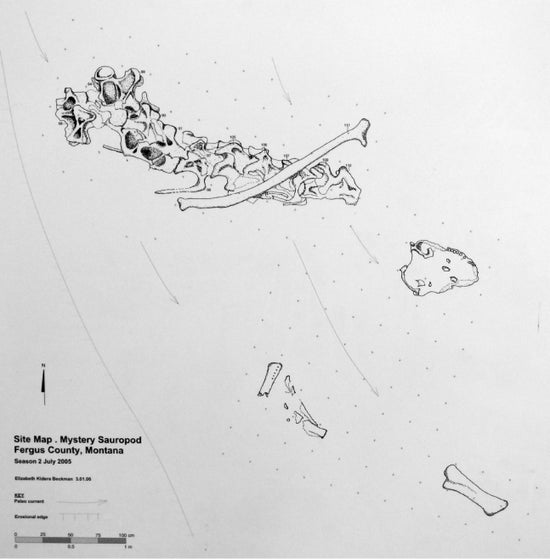This article was published in Scientific American’s former blog network and reflects the views of the author, not necessarily those of Scientific American
Think of a dinosaur. Any dinosaur. Triceratops, Allosaurus, Supersaurus. Even Pantydraco, if you must. Now, what does it look like? Chances are it’s an adult, because that’s how we most like to envision dinosaurs.
Even though all non-avian dinosaurs hatched from eggs and grew over the course of years, the most common depictions of dinosaurs – from museums to movies – are adult animals who are often the biggest representatives of the species. Yet most dinosaurs were not fully-grown when they died, and the biggest animals were not always the most mature. A partial sauropod skeleton from Montana reminds us of these basic dinosaur facts.
The fossil, described by paleontologists Cary Woodruff and John Foster, is a partial skeleton of the sauropod dinosaur Camarasaurus. This was the spoon-toothed, blunt-faced herbivore found all over the Late Jurassic rocks of western North America, and the new find – from the Little Snowy Mountains of Montana – now stands out as the northernmost occurrence of this dinosaur found so far.
On supporting science journalism
If you're enjoying this article, consider supporting our award-winning journalism by subscribing. By purchasing a subscription you are helping to ensure the future of impactful stories about the discoveries and ideas shaping our world today.

A quarry map of the Little Snowy Mountains Camarasaurus. Credit: Woodruff and Foster 2017
The skeleton includes a nearly-complete skull, vertebrae from various points along the spine, ribs, and parts of the limbs. Altogether, it was enough to confidently identify the animal as Camarasaurus and reconstruct the dinosaur’s size. As Camarasaurus go, it wasn’t particularly large. This individual was roughly elephant-sized, relatively small for a Camarasaurus, but the microscopic details of its bone structure indicate this was a mature animal. In particular, the microstructure of the dinosaur’s femur shows a feature called an External Fundamental System, accepted as a marker of fully adult body size.
Woodruff and Foster calculated that this particular Camarasaurus was about 30 to 35 years old when it perished. That’s a really good run for a dinosaur. And while this individual was on the puny side compared to others of its kind, it reminds us of a basic biological fact that’s often easy to forget when envisioning extinct creatures. Variety truly is the spice of life. One Camarasaurus certainly differed from the next just as people do (or any other organism!). Take two Camarasaurus of the same age and put them together and they’ll vary in size and proportions and other details. That’s to be expected, and, after all, variation is what offers natural selection the raw materials to keep life changing through the ages. So the next time you look at a dinosaur, don’t think of that single skeleton or individual as the absolute epitome of their species. They were just one of many, just as you are one of a species numbering over 7 billion.
Reference:
Woodruff, D., Foster, J. 2017. The first specimen of Camarasaurus (Dinosauria: Sauropoda) from Montana: the northernmost occurrence of the genus. PLOS ONE. doi: 10.1371/journal.pone.0177423